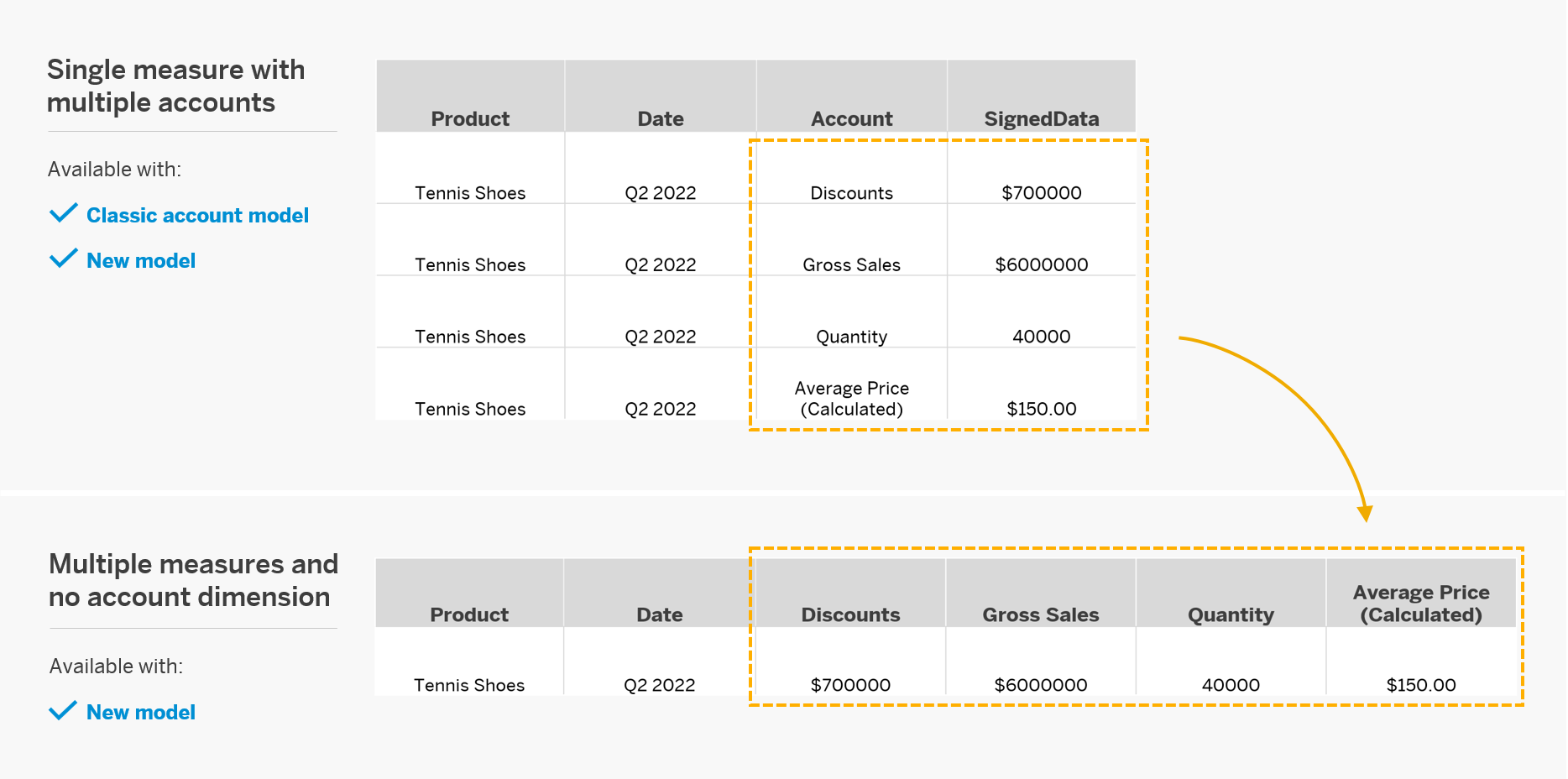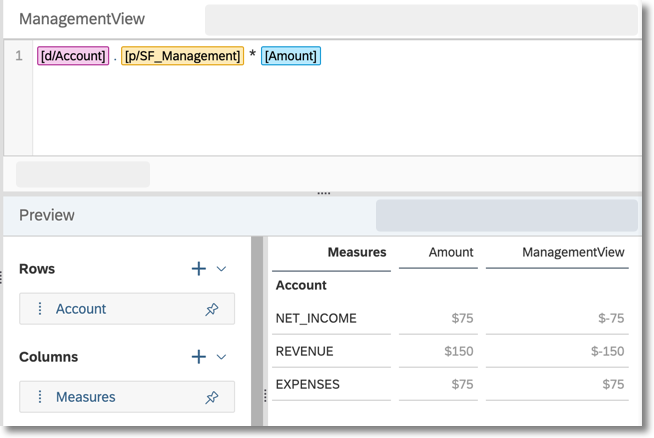Get Started with the New Model Type
A new model type is available in SAP Analytics Cloud. It lets you create measures within the model, which is a fundamental extension of the structure used by a classic account model. Known as a model with measures, the new model type provides more flexibility and adds key benefits for both analytics and planning.
Measures in SAP Analytics Cloud Models
The main difference between the model types is how they handle measures, which are the structures in your model that hold numeric values.
Measures in Classic Account Models
In a classic account model, model values are stored in a single default measure, and you use the account structure to add calculations, specify units, set up an account hierarchy, and set aggregation types for all the data.
Measures in the New Model Type
The new model type exposes measures as single entities and lets you add and configure multiple measures with aggregation and units to fit your data. It adds plenty of flexibility: you can still match the structure of a classic account model by using a single measure and an account dimension, or you can remove the account dimension when it's not required for your use case:

Refer to the Choosing a Model Configuration section to figure out the best configuration for your data, or read the Benefits of Models with Measures section to get a full list of benefits.
Benefits of Models with Measures
-
Flexible model structure: Since both accounts and measures are available as structures for your data (holding calculations and setting aggregation, units, and so on), you can display your data more precisely for a variety of use cases. You can decide whether to include an account dimension, and whether to prioritize the settings for measure or accounts. See Set Structure Priority and Create Custom Solve Order for details.
-
Accurate aggregation: Aggregating data over measures instead of accounts opens up some new options. For example, you can generate your balance sheet and profit and loss statement out of a single model.
-
Explicit data types: Measures can be set up as integers or decimals. By setting different types of data for different measures like monetary amount, number of units, operating hours, and so on, you can avoid incorrect data, for example decimals when planning on headcount values.
 With an integer measure, you can avoid decimals while still distributing the entire value
With an integer measure, you can avoid decimals while still distributing the entire value -
Optional account dimension: When you structure your data with measures, you can add your accounts to a generic dimension instead of an account dimension. This setup lets you avoid restrictions on the account dimension. See Choosing a Model Configuration for details.
-
-
Improved calculations:
-
Calculated measures in models: Since measure calculations can be added to your model, you can reuse them across different stories and analytic applications. You can also add them to some data action steps.
-
Calculations on numeric dimension properties: Using this feature, you can change account values from positive to negative based on dimension properties. For example, you can set up calculations that show either positive or negative values for expenses, which makes it easier for different types of users like controllers or accountants to analyze and plan on the same data. Refer to Changing the Signs of Your Account Values Using Numeric Properties for details.
 A calculated measure in a model that changes the signs of your account values
A calculated measure in a model that changes the signs of your account values
-
-
Enhanced currency features:
-
Base currencies and conversion measures in models: You can add multiple base currency measures to your model and then add currency conversion measures on top of them. This way, you can model and plan on multiple currencies like transaction, local, or group currencies. With currency conversions available in the model, you can use them in formulas as well as data action copy steps. For details, see Work with Currencies in a Model with Measures.
-
Planning across currencies: In tables, you can plan on any base measure or conversion measure, such as local, transaction, and group currencies, and instantly see the results across dependent currencies. And you can apply currency conversion while copying data between base measures with a data action. For details, see Plan with Currency Conversion and Convert Currencies in a Data Action.
 Entering data on a base measure and a conversion measure
Entering data on a base measure and a conversion measure
-
-
Data integration: The measure model matches the structure of data from several other SAP systems more closely, including SAP S/4 HANA, SAP BW, and SAP IBP. Data integration is generally faster and requires fewer transforms, because you can import data from multiple measures directly instead of turning them into account members.
-
Clearer terminology for charts and tables: By removing non-financial data from members of the account dimension, you can make data in charts and tables easier to understand for your viewers and content creators.
However, you might need to consider usage restrictions, both for planning and analytics models. See Restrictions for Models with Measures.
Choosing a Model Configuration
With the new model type you can pick different configurations for your model, including whether to use an account dimension or not. It's optional because each measure sets many of the same properties of an account dimension member, such as aggregation, scale, units, and whether there are currency values or not. Check the table below for an overview.
| Configuration | Description |
|---|---|
| Model with measures and an account dimension | This model configuration has two main structures, which can give
more flexibility. Consider this setup in the following cases:
|
| Model with measures and no account dimension |
A simpler configuration, this setup removes the account properties and formulas. It can also make additional features available, though. You might want to use it in these situations:
|
| Classic account model |
In some cases, you may want to keep using a classic account model:
|
Examples of Model Configuration
-
Models using currency conversion
Classic Account Model Data with Different Currencies Entity Currency Date Account Values Germany EUR March 2022 Gross Profit 1000000 Germany EUR March 2022 Operating Expense 750000 United States USD March 2022 Gross Profit 850000 United States USD March 2022 Operating Expense 600000 With the new model, you can import additional currency measures. In this case, an account dimension is helpful. Without it, your model might need many different measures, making the data more difficult to manage and analyze.
New Model Data with Different Currencies Entity Currency Date Account Local Currency Value USD Value Germany EUR March 2022 Gross Profit 1000000 800000 Germany EUR March 2022 Operating Expense 750000 600000 United States USD March 2022 Gross Profit 850000 850000 United States USD March 2022 Operating Expense 600000 600000 -
Models that show balances and changes over time
Your model may contain values for balances as well as changes over time, for example, if you're working with headcount, inventory, or capital expense data. In a classic account model, you use a dimension to separate the different types of values. In this case, it's the Flow dimension.
Classic Account Model Data with a Flow Dimension Entity Date Account Flow Values Germany March 2022 Headcount Opening 70 Germany March 2022 Headcount Transfers 5 Germany March 2022 Headcount Closing 75 Germany March 2022 Salary # 700000 Germany March 2022 Benefits # 3150000 United States March 2022 Headcount Opening 60 United States March 2022 Headcount Transfers -5 United States March 2022 Headcount Closing 55 United States March 2022 Salary # 6000000 United States March 2022 Benefits # 2700000 With the new model you can use different measures instead of a flow dimension, which lets you set the correct aggregation for each one.
New Model Data with Separate Measures for Balances and Changes Over Time Entity Date Account Expenses Opening Transfers Closing Germany March 2022 Headcount - 70 5 75 Germany March 2022 Salary 7000000 - - - Germany March 2022 Benefits 3150000 - - - United States March 2022 Headcount - 60 -5 55 United States March 2022 Salary 6000000 - - - United States March 2022 Benefits 2700000 - - -
Restrictions for Models with Measures
Usage restrictions for Account/Measures based Formulas and Calculations:
- The Link Formula between models will not be supported. You might consider using the LINK function in an advanced formulas step or cross-model copy.
- Cross-model copy steps in Data Actions don't support copying between classic account models and models with measures. Instead, you can use the LINK function in an advanced formulas step.
Usage Restrictions for Stories and Applications
- Blending is not supported when the model contains an Account dimension.
- Table Thresholds are not supported (in the classic design experience) when the model contains an Account dimension.
- For geo maps, area enrichment is not supported.
- Measures can only be sorted via Edit Member Order.
- Stories made against classic account models are not migrated and must be adjusted to the new model.
- Measure based filters are not supported in models that have both measures and account dimensions.
Data Import restrictions
- Dimension members must exist first: prior to fact data import, you need to create dimension members in modeler, or import data to global dimension.
- For SAP data center tenants, all measure columns must be mapped. For data sources with less measure column, you might consider creating a calculated column in wrangling with a constant 0 or null.
- Models created from a CSV/Excel file or data source (data first workflow) are still created as classic account model.
- In non SAP data center, incremental load isn't supported when importing data to the new model type.
- In non SAP data center, importing data to the new model needs to specify a new query from the data source. Copying of existing query associated with a model is not supported.
- Data upload into the new model doesn't support combining data function.
- The "Copy query from a model" option isn't available when importing data from a model with measures.
Microsoft Office integration restrictions
- If you migrate a classic account model already used with the add-in, you need to re-insert that model into an existing workbook created with SAP Analytics Cloud, add-in for Microsoft Office.
- You can't use the new model type with the add-ins SAP Analysis for Microsoft Office and SAP Analysis for Microsoft Office, edition for SAP Analytics Cloud.